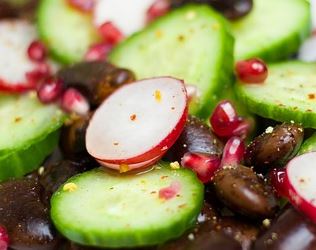How This Helps
Ayurvedic teachings place a lot of significance on the taste of food and on exploring the taste of food. This is because Ayurveda places tremendous importance on the therapeutic value of taste. Taste is essential in determining the impact that different foods, herbs, and spices will have on our body, mind, and spirit.
The Six Tastes of Ayurveda
As per Ayurveda, six tastes should be eaten by a person at every meal to feel satisfied and also to ensure that all the major food groups get represented. These six tastes are:
● Sweet
● Sour
● Salty
● Pungent or spicy
● Bitter
● Astringent
The science of Ayurveda stresses that each of these six tastes has a close relationship with the doshas of the human body and is necessary to maintain balance within the body and mind. Let us look at what each of these tastes represents.[1]
Sweet Taste
The sweet flavor is believed to represent the elements of water and earth. Sweet is commonly known to be the flavor of compassion and love.
The sweet taste is said to indicate energy. It is derived from various types of naturally occurring sugars. The sweet taste is said to be responsible for building the tissues of the body. Sweet foods are known to strengthen Kapha and decrease Vata and Pitta.[2]
However, by going overboard on sweets, you can create an imbalance of Kapha, which will then need to be corrected with bitter, pungent, and astringent foods.[3]
For people trying to gain weight, sweet taste should be emphasized as its oily, heavy, and moist features help slow down the digestion process, aiding in weight gain.
Some examples of foods that fall under sweet taste are:
● Fruits: Dates, figs, bananas, mangos, prunes
● Vegetables: Cooked carrots, olives, sweet potatoes, beets
● Meat and Fish: Pork, salmon, buffalo, beef
● Grains: Wheat, rice, corn
● Nuts and seeds: Cashews, almonds, pumpkin seeds, coconut
● Legumes: Lentils, navy beans, garbanzo beans, tofu
● Dairy and eggs: Eggs, milk, clarified butter (or ghee)
Sour Taste
We are all familiar with the sour taste of most citrus fruits. The sour flavor is a result of acids such as lactic acid, malic acid, oxalic acid, citric acid, and ascorbic acid present in our foods. Sour tasting foods tend to moisten the mouth and increase the amount of saliva in our mouth.
Sour taste strengthens Pitta, which means that it enhances all the functions associated with Pitta, such as the body’s metabolic processes. However, an excess of sour foods can aggravate Pitta, throwing it out of balance. To bring it back in balance, you will need to eat sweet and cooling foods. Kapha also gets aggravated by sour foods.
Sour taste is known to fuel the appetite, increase the production of saliva, boost the production of digestive enzymes, and also boost the body’s overall metabolism.[4] It also enhances liver function.[5]
Examples of food that come under sour taste are:
● Fruits: Lemon, lime, raisins, tamarind, grapefruit
● Vegetables: Tomatoes and pickles
● Dairy and eggs: Cheese, sour cream, yogurt, butter
● Grains: Dough bread
● Other items: Vinegar, alcohol, most fermented foods
Salty Taste
Salty taste is known to create heat and moisture. Salty taste aggravates Pitta and Kapha and balances Vata. It increases salivation in the body while supporting the absorption of food, digestion, and elimination of wastes.
The salty taste also acts as an enhancing agent for fighting depression and dullness in our lives.[4] It is essential to maintain a balance of how much salt you use because excess use causes water and/or sodium retention, which leads to the thickening of blood and blood vessels, excess thirst, swelling, and even high blood pressure.
Examples of foods that have a dominating salty taste include:
● Vegetables: Seaweed, celery
● Meat and Fish: Tuna
● Dairy: Cottage cheese
Pungent or spicy taste
The pungent or spicy taste can primarily be found in spicy foods. It represents dry heat and provides warmth to the body. It also cleanses the mouth, improves digestion, and ensures that all wastes are appropriately removed from the body.
The pungent taste helps in balancing excess Kapha in the body as it can eliminate mucus and clear up the sinuses. The pungent taste also clears congestion, moisture, and stagnation from the body.
Some examples of foods that have a pungent taste are:
● Vegetables: Garlic, onions, mustard greens, turnips, raw spinach, radishes, chilies
● Nuts and Seeds: Mustard seeds
● Grains: Spelt, buckwheat
See: Ayurveda Kapha Diet
Bitter taste
The bitter taste increases Vata and decreases Kapha and Pitta. The bitter taste is considered to be the lightest and coolest of all the six flavors, and because of these cooling properties, it is known for its detoxifying abilities. It stimulates appetite, gets rid of parasites from the gastrointestinal tract, and purifies the blood.
However, if you go overboard with a bitter flavor, then it can lead to nausea, and also weakens the lungs and kidneys due to its extreme drying ability. It can also reduce sperm production and cause osteoporosis.[6]
Some examples of bitter-tasting foods include:
● Vegetables: Leafy green vegetables such as collards, kale, yellow dock, dandelion greens; eggplant; bitter melon
● Other foods: Sesame seeds and oil, dark chocolate, coffee
Astringent Taste
Astringent is the driest flavor out of all the six tastes. The astringent taste leads to the contraction of the mucous membranes present in your mouth. This results in an immediate dry and chalky feeling in the mouth. Astringent taste aggravates Vata while balancing Kapha and Pitta.
Astringent foods and the astringent taste is associated with digestion, improved absorption, better clotting, and cleansing of the mucous membranes.[7]
Examples of astringent foods include:
● Fruits: Green bananas, cranberries, apples, pomegranate
● Vegetables: Avocado, broccoli, cabbage, raw carrots, cauliflower, peas, potatoes, beans, and most raw vegetables
● Meat: Chicken and venison
● Legumes: Most beans are astringent foods
● Grains: Rye and wheat pasta
Precautions of excess astrigent taste
If overused, the astringent taste can cause dry mouth, difficulty talking, choking, spasms, griping senses in the intestines, gas, bloating, distention, and constipation. It can also decrease libido and lower sperm counts. It can possibly lead to Bell’s palsy, emaciation, convulsions, and stroke paralysis. The excess astringent taste may also smother the digestive fire, cause thirst, stagnation inflow, cardiac fatigue, sleeplessness, stiffness, coagulation, and clotting in the blood, emotional stagnation, malaise, and even depression.
Summary
As per the fundamentals of Ayurveda, it is imperative for us to feel the taste of the foods we eat. The combination of unique flavors and tastes that are best for you depends on which dosha imbalances you suffer from, your overall constitution, your age, and also on your environment. The specifics vary from person to person. Nevertheless, a balanced diet that includes appropriate quantities of each of these six flavors will ensure that you remain in good health.







